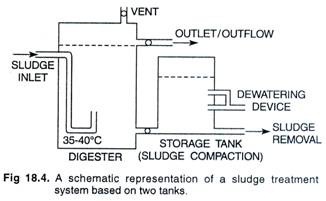anaerobic digestion
Anaerobic Treatment of Waste Water: Role of Microorganism and Sludge Treatments!
Anaerobic digestion of sewage water has been practised for over 100 years in Europe using septic tanks. ‘A single large septic tank was used for sedimentation as well as anaerobic digestion. Subsequently, baffles were added to septic tanks to aid sedimentation, and later sedimentation was separated from digestion.
Still later, digesters were developed to operate at elevated temperature of 35°C, and a variety of digester designs were developed . Efficiency of digestion was enhanced by increasing the population density of microorganisms as follows: (i) by using solid support to retain biomass, (ii) by recycling the active biomass or (iii) by limiting the biomass loss to a rate compatible with high population density in the digester.
Microorganisms:
The anaerobic digestion process involves a wide variety of organisms of which bacteria are the most predominant. These microorganisms digest the organic molecules like lipids, carbohydrates, proteins, etc. into mainly methane and CO2 . In addition, if the waste water contains sulphate (SO42-) and/or nitrate (NO3–), the following microbial activities also occur.
1. SO42- is used as electron acceptor by bacteria like Desulphovibrio during oxidation of organic compounds; they reduce SO42- to S2- as follows.
2. Denitrifying bacteria oxidise organic substrates and use NO3– as electron acceptor they liberate N2 in the process. At neutral pH, N2 is the major product of this process.
But at acidic pH, mainly nitrogen oxides are formed.
3. Methanogenic bacteria contain several cofactors not found in other bacteria. Three such cofactors are involved in the reduction of CO2 to CH4 in a stepwise fashion beginning with methanopterin (MP), followed by methanofuran (MF) and coenzyme M (CoM) in the end; the last reaction is catalysed by Factor430 (F430), the prosthetic group of CoM. These reactions are summarised below.
MP + HCO3– + 2H —— > MP – CHO + H2O + OH–
MP – CHO + MF + 2H —— > MF – CH2OH + MP
MF – CH2OH + CoM + 2H —— > CoM – CH3 + MF + H2O
CoM – CH3 + F430 + H —— > CoM + F430 + CH4
4. The ATP generation in methanogens is assumed to involve a proton motive force. According to one model, H2 is oxidized by hydrogenase on the surface of plasma membrane to generate H+, which drives ATP synthesis. Subsequently, the H+ is used for reduction of CO2 inside the cell: this process also uses up the electrons generated during H2 oxidation by hydrogenase.
Sludge Treatment:
The sewage or municipal sludge is treated to reduce odours and pathogens, and to stabilise the solids before final disposal of the sludge to landfill, as fertilizer for agriculture or in some other way. The sludge used for treatment may be the sediment from primary treatment, the activated sludge recovered after secondary aerobic treatment or scum from primary treatment tanks. The most common digester used for the purpose has the following two tanks: (i) a digester and (ii) a storage tank.
The sludge is fed into the digester tank, which is maintained at 30-40°C (mesophilic treatment). After treatment, the stabilized sludge is taken to the second tank, which is unheated and where the sludge is allowed to compact (Fig. 18.4). The performance of sludge digesters cannot be controlled, and is markedly affected by the presence of toxins, climate, seasonal changes, presence of recalcitrant Fi9 18–4 organic compounds, etc.


